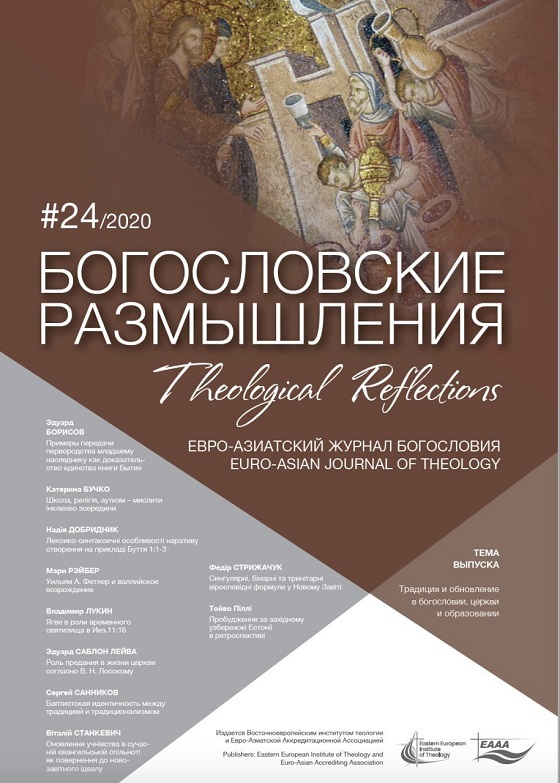THE PATTERN OF PRIMOGENITURE REVERSAL AS AN EVIDENCE FOR THE UNIFIED NATURE OF GENESIS
DOI:
https://doi.org/10.29357/2521-179X.2020.24.1Keywords:
Genesis, primogeniture, heir, sibling, reversal, election, supplanting.Abstract
The source-critical approach to biblical literature accentuated the diversity of material that constitutes ancient books of the Bible. In the past several decades, however, some scholars shifted their attention to the final canonical and literary composition of the biblical texts. This article will present a piece of evidence for the unity of the book of Genesis as a literary unit. To demonstrate this the author will trace the pattern of primogeniture reversal throughout the whole book. Arguably, the five main pairs (Cain – Abel, Ishmael – Isaac, Esau – Jacob, Reuben – Judah, Joseph, and Manasseh – Ephraim) and the two minor pairs (Leah – Rachel, Zerah – Perez) reflect six narrative features. These are parents’expectations, God’s election, a threat to the younger heir, resolution, promise to the older son, departure of the older brother. The consistent usage of this pattern leads to the conclusion that the author/editor of Genesis carefully constructed the plot of the whole book, not simply incorporated diverse material.
References
- Bibliography
- Alter, Robert. Genesis: Translation and Commentary. New York: W. W. Norton, 1996.
- Arnold, Bill T. Encountering the Book of Genesis. Grand Rapids: Baker Books, 2004.
- Brueggemann, Walter. Genesis. Interpretation: A Bible Commentary for Teaching and Preaching. Atlanta: John Knox, 1982.
- Calloud, Jean. “Figure, Knowledge and Truth: Absence and Fulfillment in the Scriptures.” Semeia 69 (1995): 61–81.
- Childs, Brevard S. Introduction to Old Testament as Scripture. Philadelphia: Fortress, 1979.
- Cohen, Norman J. “Two That Are One – Sibling Rivalry in Genesis.” Judaism 32 (1983): 331–342.
- Craig, Kenneth M. “Questions Outside Eden (Genesis 4.1-16): Yahweh, Cain and Their Rhetorical Interchange.” Journal for the Study of the Old Testament 24 (1999): 107–128.
- Enslin, Morton S. “Cain and Prometheus.” Journal of Biblical Literature 86 (1967): 88–90.
- Fishbane, Michael. Biblical Text and Texture: A Literary Reading of Selected Texts. Oxford: Oneworld, 1998.
- Fokkelman, J. P., and Ineke Smit. Reading Biblical Narrative: An Introductory Guide.Louisville: Westminster John Knox, 1999.
- Fox, Everett. “Can Genesis Be Read as a Book?” Semeia 46 (1989): 31–40.
- ———. “Stalking the Younger Brother: Some Models for Understanding a Biblical Motif.” Journal for the Study of the Old Testament 18 (1993): 45–68.
- Fresch, Cheryl H. “‘Cain Rose up against Abel’: Murder, Mystery, and ‘Paradise Lost.’” Christianity and Literature 51 (2002): 191–207.
- Ginzberg, Louis. Legends of the Jews. Translated by Henrietta Szold and Paul Radin. 2nd ed. 2 vols. JPS Classic Reissues. Philadelphia: The Jewish Publication Society, 2003.
- Goldin, Judah. “Youngest Son or Where Does Genesis 38 Belong.” Journal of Biblical Literature 96 (1977): 27–44.
- Greenspahn, Frederick E. When Brothers Dwell Together: The Preeminence of Younger Siblings in the Hebrew Bible. Oxford: Oxford University Press, 1994.
- Greidanus, Sidney. “Preaching Christ from the Cain and Abel Narrative.” Bibliotheca Sacra 161 (2004): 387–397.
- Hamilton, Victor P. The Book of Genesis: Chapters 1-17. The New International Commentary on the Old Testament. Grand Rapids: Eerdmans, 1990.
- Howard Jacobson. “Short Notes: Genesis IV 8.” Vetus Testamentum 55 (2005): 564–565.
- Kramer, Phyllis Silverman. “Biblical Women That Come in Pairs: The Use of Female Pairs as a Literary Device in the Hebrew Bible.” In Genesis: The Feminist Companion to the Bible (Second Series), edited by Athalya Brenner, 218–232. Sheffield: Sheffield Academic, 1998.
- Lohr, Joel N. “Righteous Abel, Wicked Cain: Genesis 4:1-16 in the Masoretic Text, the Septuagint, and the New Testament.” Catholic Biblical Quarterly 71 (2009): 485–496.
- Matthews, Victor H., and Frances Mims. “Jacob the Trickster and Heir of the Covenant: A Literary Interpretation.” Perspectives in Religious Studies 12 (1985): 185–195.
- Reno, Russell R. Genesis. Brazos Theological Commentary on the Bible. Grand Rapids: Brazos, 2010.
- Sandy, D. Brent, and Ronald L. Giese Jr. Cracking Old Testament Codes: A Guide to Interpreting Old Testament Literary Forms. Nashville: Broadman & Holman, 1995.
- Swenson, Kristin M. “Care and Keeping East of Eden: Gen 4:1-16 in Light of Gen 2-3.” Interpretation: A Journal of Bible & Theology 60 (2006): 373–384.
- Syrén, Roger. The Forsaken Firstborn: A Study of a Recurrent Motif in the Patriarchal Narratives. JSOTSup 133. Sheffield: Sheffield Academic, 1993.
- Walton, John H. Genesis. The NIV Application Commentary. Grand Rapids: Zondervan, 2001.
- Wenham, Gordon J. “The Face at the Bottom of the Well: Hidden Agendas of the Pentateuchal Commentator.” In He Swore an Oath: Biblical Themes from Genesis 12-50, edited by Richard S. Hess, P. E. Satterthwaite, and Gordon J. Wenham, 185–209. Cambridge: Tyndale House Publishers, 1993.
Downloads
Published
How to Cite
Issue
Section
License
Copyright (c) 2020 Eduard BORYSOV

This work is licensed under a Creative Commons Attribution-NonCommercial 4.0 International License.
All articles published in the Journal are distributed under a Creative Commons Attribution-NonCommercial 4.0 International License
By submitting an article for publication in Theological Reflections: Eastern European Journal of Theology the author grants the editors the right to publish the article and distribute it in electronic and print form.
The author reserves all copyrights and the right to use the materials of the article in whole or in part for educational purposes, to write his own dissertations, to prepare abstracts, conference reports, oral presentations, etc., as well as post electronic copies of articles (including the final electronic version downloaded from the journal’s official website) on non-commercial web-resources without the consent of the editorial board and founders.



